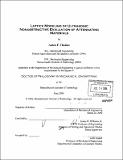Lattice modeling of ultrasonic nondestructive evaluation of attenuating materials
Author(s)
Thomas, Anton F. (Anton Felipe), 1977-
DownloadFull printable version (18.56Mb)
Other Contributors
Massachusetts Institute of Technology. Dept. of Mechanical Engineering.
Advisor
James H. Williams, Jr.
Terms of use
Metadata
Show full item recordAbstract
Theoretical predictions of specific strength and specific stiffness of nanocomposites make them attractive replacements for alloys and fiber reinforced composites in future generations of numerous structures. The reliable and safe utilization of nanocomposites will require their periodic characterization with nondestructive evaluation. When subjected to ultrasonic waves, nanocomposites often exhibit attenuation that is an order of magnitude higher than that of carbon fiber reinforced polymeric composites. Thus, an accurate model of ultrasonic wave propagation in nanocomposites as well as several other modem composites must include attenuation. Lattice modeling is a heuristic approach that consists of the discretization of solids into regularly spaced particles interconnected via nearest-neighbor interactions. For example, the mass-spring-lattice model (MSLM), a lattice model for the simulation and visualization of elastic wave propagation, has been used in favor of other finite-difference and finite-element methods due to its straightforward implementation of boundary conditions and relatively inexpensive explicit numerical integration. Its utility notwithstanding, MSLM discretization produces documented, yet previously unresolved and uncharacterized, numerical errors. (cont.) In addressing errors associated with numerical anisotropy and surface wave propagation, two main points are revealed. (1) For isotropic materials having a Poisson's ratio less than 0.4, 20 grid spaces per shear wavelength are required to ensure phase speed errors of less than 1%. (2) For precise implementation of MSLM traction boundaries, correction terms are formulated. Further, the MSLM is not capable of modeling ultrasonic wave propagation in nanocomposites and many thick composites, polymers, and nanocrystalline metals, in part, because of the associated losses due to attenuation. The mass-spring-dashpot lattice model (MSDLM) is therefore formulated to simulate and visualize wave phenomena in attenuating, viscoelastic media. Via the dispersion relations for a standard linear solid, the MSDLM spring and dashpot constants are set to match the corresponding wave propagation phase speeds and attenuation. The convergence, stability, and accuracy criteria for the MSDLM are presented for one and two-dimensional models. Additional verification is provided through numerical examples and comparisons with known solutions. (cont.) The homogenization of the elastic and viscoelastic mechanical properties of the nanocomposite constituents is implied in the use of the MSDLM. Assuming the characteristic wavelength is much larger than the characteristic length scale of the interrogated nanocomposite phases, interaction of ultrasonic waves with nanometer constituents is captured by the inherent, frequency-dependent attenuation. The homogenization of the elastic and viscoelastic mechanical properties of the nanocomposite constituents is implied in the use of the MSDLM. Assuming the characteristic wavelength is much larger than the characteristic length scale of the interrogated nanocomposite phases, interaction of ultrasonic waves with nanometer constituents is captured by the inherent, frequency-dependent attenuation.
Description
Thesis (Ph. D.)--Massachusetts Institute of Technology, Dept. of Mechanical Engineering, 2006. Page 208 blank. Includes bibliographical references.
Date issued
2006Department
Massachusetts Institute of Technology. Department of Mechanical EngineeringPublisher
Massachusetts Institute of Technology
Keywords
Mechanical Engineering.